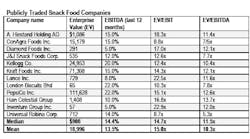Over the past several years, the volume of food industry mergers and acquisitions (M&A) transactions has risen consistently, according to research conducted by Grant Thornton Corporate Finance (GTCF), a wholly owned subsidiary of Chicago-based Grant Thornton LLP. In fact, M&A volume has doubled since 2005, from 1,000 to 2,000 transactions in 2007.
“While first quarter 2008 is relatively flat in volume, the average deal multiple has gone up,” says Brian Basil, a director of GTCF. “Factors affecting the volume of M&A transactions include the recent credit market turmoil, which has impacted the ability of financial buyers to compete with strategic buyers for attractive transaction targets. Also, the appetite among foreign buyers and investors for U.S. food businesses has increased as a result of the weakened U.S. dollar.”
The GTCF Food Index is made up of a cross section of food industry participants, broadly classified as food processors, distributors and retailers. The GTCF Index shows food processors, including many of the large branded food companies, have outperformed the broader market primarily due to strong brands and staple food offerings. Food distributors and retailers have not kept pace with the S&P 500 index. Rising prices in fuel and commodities have put tremendous pressure on profit margins of both food distributors and retailers.
Consolidation should continue to shape the market. “M&A activity will play a big role as many of the larger companies look to augment internal product development with strategic acquisitions, and private equity buyers look for acquisitions of companies with outstanding growth potential,” says Basil. “And strong companies will continue to garner relatively high transaction multiples, regardless of transaction volumes.”
Athens, Greece-based Vivartia Industrial purchased Tulsa, Okla.-based Nonni’s Food Co. Valued at $320 million, approximately 10x EBITDA, Nonni’s combined technical know-how and U.S. presence made it an attractive acquisition.
According to Grant Thornton’s 2007 Survey of U.S. Food and Beverage Companies, a focus on health and wellness remains a key revenue driver for the food industry. In fact, 54 percent of respondents said the “better-for-you” category was the food group that offered the most potential for revenue growth.
“Branded food companies are snapping up smaller brands as their new products get traction in the marketplace,” says Basil. “Smaller companies exhibiting strong growth make the most attractive acquisition candidates.”
And he adds, “When a small company creates a unique ‘hot’ snack, the big branded food company is quick to acquire the brand in an effort to pump it through their distribution system, market it, and build that product up in a way the smaller company can’t.”


